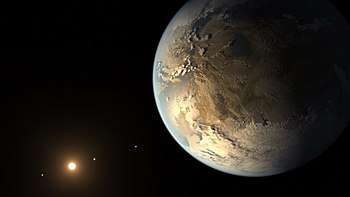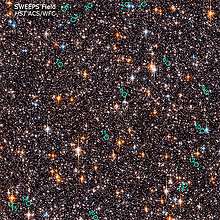Large Ultraviolet Optical Infrared Surveyor
The Large Ultraviolet Optical Infrared Surveyor, commonly known as LUVOIR (/ˈluːvɑːr/), is a multi-wavelength space observatory concept being developed by NASA under the leadership of a Science and Technology Definition Team. It is one of four large astrophysics space mission concepts being studied in preparation for the National Academy of Sciences 2020 Astronomy and Astrophysics Decadal Survey.[1][2] While LUVOIR is a concept for a general-purpose observatory, it has the key science goal of characterizing a wide range of exoplanets, including those that might be habitable. An additional goal is to enable a broad range of astrophysics, from the reionization epoch, through galaxy formation and evolution, to star and planet formation. Powerful imaging and spectroscopy observations of Solar System bodies would also be possible. LUVOIR would be a Large Strategic Science Mission and will be considered for a development start sometime after 2020. The LUVOIR Team has produced designs for two variants of LUVOIR: one with a 15 m diameter telescope mirror (LUVOIR-A) and one with an 8 m diameter mirror (LUVOIR-B).[3] LUVOIR can observe ultraviolet, visible, and near-infrared wavelengths of light. The Final Report on the 3.5-year LUVOIR mission concept study was publicly released on August 26, 2019.[4]
 Rendering of the LUVOIR-A observatory concept | |
| Names | LUVOIR |
|---|---|
| Website | www |
| Spacecraft properties | |
| Spacecraft type | Space observatory |
| Start of mission | |
| Launch date | Late-2030s (proposed) |
| Orbital parameters | |
| Reference system | Sun-Earth Lagrange 2 point |
| Main | |
| Diameter | 8 or 15 m (26 or 49 ft) |
| Wavelengths | UV, visible and infrared |
 Mission proposal insignia | |
Background
In 2016, NASA began considering four different space telescope concepts for future Large Strategic Science Missions.[5] They are the Habitable Exoplanet Imaging Mission (HabEx), Large Ultraviolet Optical Infrared Surveyor (LUVOIR), Lynx X-ray Observatory, and Origins Space Telescope (OST). In 2019, the four teams will turn their final reports over to the National Academy of Sciences, whose independent Decadal Survey committee advises NASA on which mission should take top priority. If funded, LUVOIR would launch in approximately 2039 using a heavy launch vehicle, and it would be placed in an orbit around the Sun–Earth Lagrange 2 point.[4]
Mission

LUVOIR's main goals are to investigate exoplanets, cosmic origins, and the Solar System.[3] LUVOIR would be able to analyze the structure and composition of exoplanet atmospheres and surfaces. It could also detect biosignatures arising from life in the atmosphere of a distant exoplanet.[6] Atmospheric biosignatures of interest include CO
2, CO, molecular oxygen (O
2), ozone (O
3), water (H
2O), and methane (CH
4). LUVOIR's multi-wavelength capability would also provide key information to help understand how a host star's UV radiation regulates the atmospheric photochemistry on habitable planets. LUVOIR will also observe large numbers of exoplanets spanning a wide range of characteristics (mass, host star type, age, etc.), with the goal of placing the Solar System in a broader context of planetary systems. The scope of astrophysics investigations that LUVOIR can do is vast, covering all the topics addressed with the Hubble Space Telescope and more. Experiments extremely difficult or impossible to execute with Hubble's 2.4 m diameter mirror become possible with LUVOIR. These investigations include explorations of cosmic structure in the far reaches of space and time, formation and evolution of galaxies, and the birth of stars and planetary systems. In the area of Solar System studies, LUVOIR can provide up to about 25 km imaging resolution in visible light at Jupiter, permitting detailed monitoring of atmospheric dynamics in Jupiter, Saturn, Uranus, and Neptune over long timescales. Sensitive, high resolution imaging and spectroscopy of Solar System comets, asteroids, moons, and Kuiper Belt objects that will not be visited by spacecraft in the foreseeable future can provide vital information on the processes that formed the Solar System ages ago. Furthermore, LUVOIR has an important role to play by studying plumes from the ocean moons of the outer Solar System, in particular Europa and Enceladus, over long timescales.
Design
LUVOIR would be equipped with an internal coronagraph instrument (called ECLIPS) to enable direct observations of Earth-like exoplanets. An external starshade is also an option for the smaller LUVOIR design (LUVOIR-B). Other candidate science instruments studied are: High-Definition Imager, a wide-field near-UV, optical, and near-infrared camera; LUMOS, an ultraviolet multi-object spectrograph; and POLLUX, an ultraviolet spectropolarimeter. POLLUX is being studied by a European consortium, with leadership and support from the French Space Agency. The observatory can observe wavelengths of light from the far-ultraviolet (1,000 Å) to the near-infrared (25,000 Å). To enable the extreme wavefront stability needed for coronagraphic observations of Earth-like exoplanets,[7] the LUVOIR design incorporates three principles. First, vibrations and mechanical disturbances throughout the observatory are minimized. Second, the telescope and coronagraph both incorporate several layers of wavefront control through active optics. Third, the telescope is actively heated to a precise 270 K (26 °F) to control thermal disturbances. The LUVOIR technology development plan is supported with funding from NASA's Astrophysics Strategic Mission Concept Studies program, the Goddard Space Flight Center, the Marshall Space Flight Center, the Jet Propulsion Laboratory and related programs at Northrop Grumman Aerospace Systems and Ball Aerospace.
LUVOIR-A

LUVOIR-A, previously known as the High Definition Space Telescope (HDST), would be composed of 36 mirror segments with an aperture of 15 m (49 ft) in diameter, offering images up to 24 times sharper than the Hubble Space Telescope.[8] LUVOIR-A would be large enough to find and study the dozens of Earthlike planets in our nearby neighborhood. It could resolve objects such as the nucleus of a small galaxy or a gas cloud on the way to collapsing into a star and planets.[9] The first study for the HDST was published by the Association of Universities for Research in Astronomy (AURA) on July 6, 2015.[9] If selected for funding, it may launch sometime in the 2030s.[8] The case in favor of HDST was made in a report entitled "From Cosmic Birth to Living Earths", on the future of astronomy commissioned by AURA, which runs the Hubble and other observatories on behalf of NASA and the National Science Foundation.[10] The AURA group is using the report to start the selection process by which major scientific projects are chosen and funded. Every 10 years, a committee of the National Academy of Sciences surveys the astronomical community and produces a prioritized wish list for the next decade. This survey, which happens next in 2020, provides a guide for Congress and NASA.[11] Ideas for the original HDST proposal included an internal coronagraph, a disk that blocks light from the central star, making a dim planet more visible, and a starshade that would float kilometers out in front of it to perform the same function.[11] Initial cost estimates are approximately $10 billion.[11] LUVOIR-A folds so it only needs an 8-metre wide payload fairing.[4] Launch options include SLS block 1B and Starship.[12]
LUVOIR-B
LUVOIR-B, previously known as the Advanced Technology Large-Aperture Space Telescope (ATLAST),[13][14][15][16] is an 8–meter architecture initially developed by the Space Telescope Science Institute,[17] the science operations center for the Hubble Space Telescope. While smaller than LUVIOR-A, it is being designed to produce an angular resolution that is 5–10 times better than the James Webb Space Telescope, and a sensitivity limit that is up to 2,000 times better than HST.[13][14][17] The LUVOIR team expects that the telescope would be able to be serviced – similar to HST – either by an uncrewed spacecraft or by astronauts via Orion or Starship. Instruments such as cameras could potentially be replaced and returned to Earth for analysis of their components and future upgrades.[16]
The original backronym used for the initial mission concept, "ATLAST", was a pun referring to the time taken to decide on a successor for HST. ATLAST itself had three different proposed architectures – an 8 meters (26 ft) monolithic mirror telescope, a 16.8 meters (55 ft) segmented mirror telescope, and a 9.2 meters (30 ft) segmented mirror telescope. The current LUVOIR-B architecture adopts JWST design heritage, essentially being an incrementally larger variant of the JWST, which has a 6.5 m segmented main mirror. Running on solar power, it would use an internal coronagraph or an external occulter, can characterize the atmosphere and surface of an Earth-sized exoplanet in the habitable zone of long-lived stars at distances up to 140 light-years (43 pc), including its rotation rate, climate, and habitability. The telescope would also allow researchers to glean information on the nature of the dominant surface features, changes in cloud cover and climate, and, potentially, seasonal variations in surface vegetation.[18] LUVOIR-B was designed to launch on a heavy-lift rocket with an industry-standard 5 m (16 ft) diameter launch fairing. Options for launch of LUVOIR-B may include NASA's SLS Block 1 rocket, Blue Origin's New Glenn and Starship.[19]
See also
References
- Foust, Jeff (January 21, 2019). "Selecting the next great space observatory".
- "The National Academies of Sciences, Engineering, and Medicine, 2020 Decadal Survey on Astronomy and Astrophysics (Astro2020)".
- Myers, J. D. "Official NASA website for LUVOIR". NASA.
- "LUVOIR Mission Concept Study Final Report". August 26, 2019.
- Scoles, Sarah (March 30, 2016). "NASA Considers Its Next Flagship Space Telescope". Scientific American. Retrieved August 15, 2017.
- Trager, Rebecca (March 7, 2018). "Searching for the chemistry of life on exoplanets".
- "NASA Exoplanet Exploration Program Technology Overview".
- "High Definition Space Telescope — Hubble's Successor?". July 21, 2015. Retrieved July 24, 2015.
- "AURA Releases Study of Future Space Telescope". Archived from the original on February 1, 2017. Retrieved July 24, 2015.
- "AURA Report". From Cosmic Birth to Living Earths. Retrieved July 24, 2015.
- Overbye, Dennis (July 13, 2015). "The Telescope of the 2030s". The New York Times. ISSN 0362-4331. Retrieved July 24, 2015.
- "NASA Team Lays Plans to Observe New Worlds". NASA. July 23, 2014.
- Postman, Marc; et al. (April 6, 2009). "Advanced Technology Large-Aperture Space Telescope (ATLAST): A Technology Roadmap for the Next Decade". RFI Submitted to Astro2010 Decadal Committee. arXiv:0904.0941. Bibcode:2009arXiv0904.0941P.
- Reddy, Francis (August 2008). "Where will astronomy be in 35 years?". Astronomy.
- "LUVOIR - Design". NASA. Retrieved April 1, 2020.
- "ATLAST — Advanced Technology Large-Aperture Space Telescope". Space Telescope Science Institute.
- Postman, M.; Traub, W. A.; Krist, J.; et al. (November 19, 2009). Advanced Technology Large-Aperture Space Telescope (ATLAST): Characterizing Habitable Worlds. Pathways Towards Habitable Planets Symposium. 14-18 September 2009. Barcelona, Spain. arXiv:0911.3841. Bibcode:2010ASPC..430..361P.
- Goddard Space Flight Center [@NASAGoddard] (April 11, 2019). "We asked and @SpaceX checked. The #LUVOIR space telescope concept can indeed fly on Starship!" (Tweet) – via Twitter.
External links
| Wikimedia Commons has media related to |
- Large Ultraviolet Optical Infrared Telescope project website
- Large UV/Optical/IR Surveyor at the Goddard Space Flight Center
- Advanced Technology Large-Aperture Space Telescope at the Goddard Space Flight Center
- Advanced Technology Large-Aperture Space Telescope at STScI
- High Definition Space Telescope at AURA

